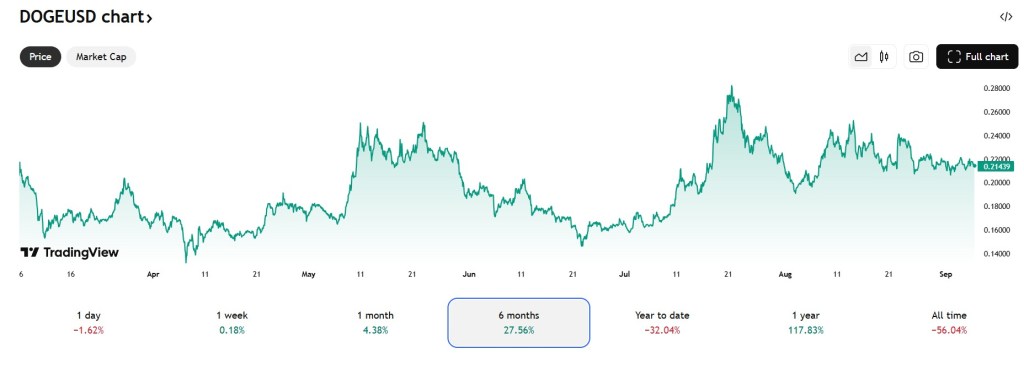Kolejny rajd Dogecoina? Analiza trendów i nowe wyzwania dla rynku memecoinów w 2025 roku
Dogecoin od lat pozostaje synonimem memecoinów. W ostatnich tygodniach wokół DOGE znów zrobiło się głośno. Głównym powodem było utrzymanie kluczowego poziomu wsparcia na 0,21 USD. Swoje dołożył także pojawiające się informacje o dużych inwestycjach instytucjonalnych w infrastrukturę związaną z tą kryptowalutą.
W tle tej narracji rodzi się jednak nowa fala projektów inspirowanych sukcesem Dogecoina. Jednym z nich jest Maxi Doge. Memecoin w krótkim czasie zdobył uwagę społeczności dzięki unikalnej narracji i dynamicznej przedsprzedaży.
Czy DOGE rzeczywiście szykuje się do historycznego rajdu w kierunku 1–2 dolarów?
Dogecoin utrzymuje wsparcie i kusi wizją super rajdu
Dogecoin, według wielu analityków, znajduje się w kluczowym momencie. Ostatnie tygodnie pokazały, że kurs utrzymuje się powyżej poziomu 0,21 USD, czyli granicy, która w przeszłości wielokrotnie działała jako trampolina dla dalszych wzrostów.

Eksperci wskazują także na formację cup-and-handle, która w analizie technicznej często zapowiada dynamiczne wybicie w górę. Początkowy cel to 0,30 USD, jednak najbardziej optymistyczne scenariusze zakładają, że w sprzyjających warunkach DOGE może nawet osiągnąć poziom 2 USD.
Takie prognozy opierają się nie tylko na wykresach, ale także na wydarzeniach fundamentalnych.
We wrześniu pojawiły się między inymi informacje o inwestycji 50 milionów dolarów w koparki Dogecoina przez Thumzup Media Corporation, firmę notowaną na Nasdaq, wspieraną przez Donalda Trumpa Jr.
Dzięki temu DOGE mining może generować roczne przychody rzędu nawet 100 milionów dolarów, co zwiększa długoterminowy potencjał sieci. Czy to czas na kolejny rajd dogecoina?
Instytucje i ETF-y jako paliwo dla wzrostów
Nie bez znaczenia jest również otoczenie regulacyjne. Po zatwierdzeniu pierwszych ETF-ów na Bitcoina i Ethereum, rynek oczekuje, że podobny instrument inwestycyjny może wkrótce pojawić się także dla Dogecoina. Wnioski w tej sprawie złożyły już chociażby 21Shares, Bitwise i Grayscale.
ETF na DOGE mógłby stać się ogromnym katalizatorem wzrostów, otwierając drzwi dla instytucji i inwestorów detalicznych, którzy dotąd nie mieli łatwego dostępu do tego rynku.
Jeśli te oczekiwania się zmaterializują, niektórzy analitycy nie wykluczają powtórki z historii Bitcoina, który po zatwierdzeniu ETF-ów zwiększył swoją kapitalizację o ponad 1 bilion dolarów.
Nowa fala memecoinów
Choć DOGE pozostaje ikoną, rynek memecoinów dynamicznie się rozwija. Oprócz Shiba Inu czy Floki, coraz częściej mówi się o nowych projektach, które próbują wnieść świeżość do niszy krpyto.
Jednym z nich jest Maxi Doge. Projekt powstał jako ultranapakowany kuzyn Dogecoina. Jego historia bazuje na idei, że Maxi to pies po siłowni, który po latach życia w cieniu swojego słynnego krewniaka postanowił wziąć sprawy w swoje ręce i zdominować rynek.
Maxi Doge – co to jest?
Czym jest Maxi Doge? Wbrew pozorom to nie tylko kolejnym memecoinem z psem w logo. To projekt zbudowany na fundamencie silnej narracji, który od razu przyciągnął społeczność dynamicznym marketingiem i atrakcyjną tokenomiką.
Presale zebrał już blisko 2 miliony dolarów, a inwestorzy chętnie lokują środki ze względu na rosnący kurs w kolejnych etapach przedsprzedaży oraz możliwość uzyskania wysokiego oprocentowania dzięki stakingowi.
Token $MAXI działa w oparciu o sieć Ethereum, a jego twórcy zaplanowali rozbudowaną roadmapę obejmującą listingi na DEX-ach i CEX-ach, partnerstwa z influencerami oraz wprowadzenie handlu z dźwignią nawet do 1000x.
To sprawia, że część inwestorów zastanawia się, jakie altcoiny kupić? Wśród typowych propozycji znajdują się oczywiście Ethereum czy Solana.
Trzeba jednak przyznać, że memecoiny takie jak Maxi Doge zaczynają odgrywać coraz ważniejszą rolę w portfelach traderów szukających wysokiego ryzyka i jeszcze wyższych potencjalnych zysków.
ODWIEDŹ OFICJALNĄ STRONĘ MAXI DOGE
Tokenomika i unikalne cechy Maxi Doge
Maxi Doge wyróżnia się na tle innych memecoinów kilkoma kluczowymi elementami:
- Mocna narracja – historia o kuzynie DOGE jest prosta, zabawna i łatwa do rozpowszechniania w sieci.
- Staking od startu – nagrody sięgające kilkuset procent rocznie w fazie presale to rzadkość w świecie memecoinów.
- MAXI Fund – 25% podaży tokenów przeznaczono na marketing i partnerstwa, co ma zapewnić długoterminowe budowanie marki.
- Społeczność – projekt celuje w traderów, którzy lubią ryzyko i intensywne tempo działania, co buduje lojalną grupę hodlerów.
Dzięki tym cechom wielu komentatorów uważa, że Maxi Doge może w krótkim czasie dołączyć do grona projektów określanych mianem najlepsze nowe memecoiny.
Dogecoin kontra Maxi Doge, rywalizacja o miano króla memecoinów
Porównując DOGE i MAXI, można zauważyć interesujący kontrast. Dogecoin to projekt z 10-letnią historią, ogromną rozpoznawalnością i rosnącym zainteresowaniem instytucji. Z kolei Maxi Doge dopiero rozpoczyna swoją drogę, ale dysponuje energią i świeżością, które mogą przyciągnąć nową falę inwestorów.
Nie jest tajemnicą, że memecoiny często zyskują głównie dzięki narracji i sile społeczności. Jeśli DOGE utrzyma wsparcie i skorzysta na potencjalnym ETF-ie, może czekać go kolejny rozdział dynamicznych wzrostów.
Jednak równolegle projekty takie jak Maxi Doge stanowią alternatywę dla inwestorów, którzy chcą wejść na rynek wcześniej i poszukać okazji o wyższym potencjale zwrotu.
Rok 2025 może okazać się przełomowy dla rynku memecoinów. Dogecoin stoi przed szansą historycznego rajdu, który dochodząc do skutku wprowadzi go na zupełnie inny poziom.
Instytucjonalne inwestycje, możliwe ETF-y oraz pozytywne sygnały techniczne budują mocny fundament pod przyszłe wzrosty.
ODWIEDŹ OFICJALNĄ STRONĘ MAXI DOGE
You May Also Like

US Spot ETH ETFs Witness Remarkable $244M Inflow Surge

First Ethereum Treasury Firm Sells ETH For Buybacks: Death Spiral Incoming?

